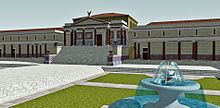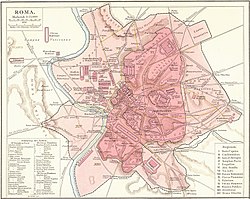Curia of Pompey
 |
|
| Location | Regione IX Circus Flaminius |
|---|---|
| Built in | 62 BC |
| Built by/for | Gnaeus Pompeius Magnus |
| Type of structure | Exedra |
| Related | Theatre of Pompey, Porticus of Pompey, Roman Republic, Pompey, Julius Caesar, Assassination of Julius Caesar, Mark Antony, Marcus Junius Brutus, Marcus Licinius Crassus, Cicero, First Triumvirate |
The Curia of Pompey, sometimes referred to as the Curia Pompeia, was one of several named meeting halls from Republican Rome of historic significance. A curia was a designated structure for meetings of the senate. The Curia of Pompey was located at the entrance to the Theater of Pompey. While the main senate house was being moved from the Curia Cornelia to a new Curia Julia, the senate would meet in this smaller building. It is best known as where members of the Roman Senate murdered Gaius Julius Caesar. It was attached to the porticus directly behind the theatre section and was a Roman exedra, with a curved back wall and several levels of seating. In "A New Topographical Dictionary of Ancient Rome" by L. Richardson, Jr., Richardson states that after Caesar's murder, Augustus Caesar removed the large statue of Pompey and had the hall walled up. Richardson cited Suetonius that it was later made into a latrine, as stated by Cassius Dio.
In 55 BC, Gnaeus Pompeius Magnus (Pompey) dedicated the opening of the largest theatre in the ancient world before its full completion. Built from the profits of his war campaigns, the structure was a political statement meant to raise the status of the Roman general and consul and to memorialise his achievements throughout his career. That would be copied later by the Roman emperors when they created their own imperial forums.
The full structure consisted of a large theatre section, incorporating a temple, a pulpitum or stage, scaenae frons and cavea (seating) at one end, a large quadriporticus that surrounded an extensive garden and housed Pompey's collection of art and literature and the curia itself at the opposite end from the theatre. While the theatre complex stood for centuries, the curia lasted for only about a decade. In 44 BC, Caesar was murdered by a conspiracy of senators. Afterwards, the structure was closed and walled up and was said to have been set on fire; a latrine was put in its place some years later.
...
Wikipedia

